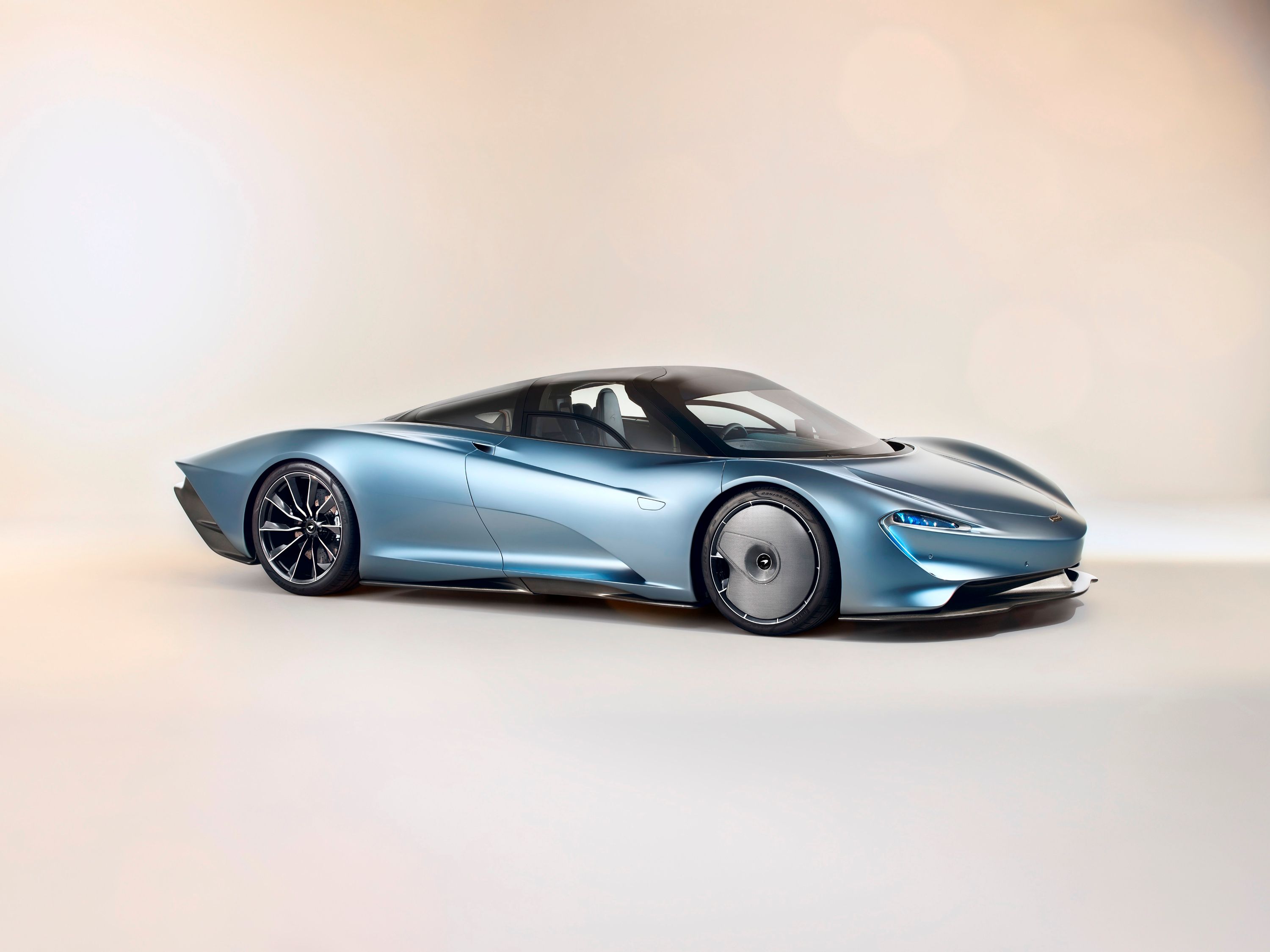
The Mclaren F1 was a true poster car of the 1990s. It usurped all that came before it in every conceivable way. The three-seater supercar had a central driving position, striking design, a gold-lined engine bay, and a naturally aspirated BMW-sourced V12 mounted amidship, but the cherry on the top was the records it set, becoming the fastest car in the world on March 31, 1998 at a speed of 240.1 mph. Ever since the last of 106 McLaren F1s were produced in 1998, the world has been waiting for something to live up to the hype. Sure, there were cars that went faster, like the Bugatti Veyron Super Sport and Koenigsegg Agera RS, but the hype that surrounded the F1 was still unmatched.
22 years we've waited for a successor, and now we have two, both of which boast three seats, a central driving position, limited production runs of around 100 units, and genuine links to the legend itself. We're talking about none other than the McLaren Speedtail and the Gordon Murray Automotive T.50. The parents of the F1 might have divorced, but each is back with their own interpretation of its successor, and we're here to tell you which is better.
Design: The Magic Happens In The Tail
The designer of the original McLaren F1 was none other than Formula 1 designer, Gordon Murray. He took the F1 from concept car to road-going legend and was the man behind the legendary central driving perch and the three-seat cockpit. Both the McLaren Speedtail and the GMA T.50 - the latter also designed by Murray - inherit the basic concept of the F1: both are mid-engined machines, which automatically imbues them with a cab-forward stance, and both have butterfly-type dihedral doors. That's where the similarities end.
The Speedtail appears as a monstrosity compared to the original F1, more akin to the 'Longtail' GTR versions that raced at Le Mans. It's all about the aero, with the long tail providing negative pressure zones under the car that suck it to the ground and provide stability at speed without adding drag. It's a slippery character, too, with aerodynamic wheel covers to aid how it slips through the air, although McLaren has made no official claim as to its drag coefficient.
Conversely, the GMA T.50 looks too simple from most angles. Its proportions are near-on identical to those of the F1 with incredibly short overhangs, front and rear. It's easily identifiable as a successor to the F1, however, with a front end design that is nothing if not familial. But it's at the back where the magic happens. Taking influence from the Brabham BT46 Formula 1 'fan car', also designed by Murray, the T.50 has a ground-effect fan that evacuates air from under the car and helps it cleanly exit the rear of the body. It's a remarkable design element but also allowed Murray to leave the rest of the design uncluttered and unafflicted by wings and active aero toys.
Which looks better? Well, we're inclined to suggest that Murray got it right, and while the T.50 might be accused as looking too boring, it embodies the ethos of the F1's compact nature perfectly. The Speedtail might be a true form-follows-function design, but it looks overwrought and alien, designed by a wind tunnel and not a human being.
Performance: Turbos and Hybrids vs. Natural Aspiration and Light Weight
Again, the philosophies between these two machines differ immensely. While the original F1 had a BMW-sourced 6.1-liter V12 engine developing 618 horsepower and 489 lb-ft of torque, times have changed, and turbos and hybridization are now the order of the day.
That didn't stop Gordon Murray from commissioning Cosworth to build him a naturally aspirated V12 from the ground up. Measuring 3.9 liters in displacement, the V12 delivers 654 hp and just 344 lb-ft, or up to 690 hp in V-Max Boost mode for a short period. The torque figure is particularly concerning, down substantially on the original F1, but while the legend could only rev up to 7,500 rpm, the T.50's redline arrives at a stratospheric 12,100 rpm, and the engine will rev from idle to that point in the blink of an eye. You have to wring the T.50's powerplant to high heavens to enjoy it fully, and while no claims have been made of the car's 0-60 mph time or even its top speed - yet - the six-speed manual and promise of a howling V12 are hard to ignore.
Contrarily, McLaren has embraced the era of turbocharging, equipping the Speedtail with a 4.0-liter twin-turbo V8 paired to a hybrid-electric system. The combination develops a total output of 1,035 hp and 848 lb-ft, mated to a seven-speed dual-clutch automatic gearbox. McLaren also doesn't make any 0-60 mph claims here, but with a top speed limited to 250 mph, not only is the Speedtail faster than the F1, but it's the fastest McLaren, ever. It's rapid in getting there, too, and 0-186 mph takes just 12.8 seconds.
On paper, the Speedtail dominates, but it weighs 3,153 lbs. The T.50? It's a true featherweight, tipping the scales at lighter than a Mazda MX-5 Miata - 2,174 lbs to be exact. It has a power to weight ratio that outstrips the track-focused McLaren Senna, and it points towards the T.50's purpose. While many remember the F1 for its top speed, it was actually remarkable to drive. It was agile, nimble, and spectacular around the corners, and that's what Murray sought to emulate with the T.50. We're not saying the Speedtail won't do all these things too, but it's a lardy fellow by comparison, and McLaren has made no attempt to hide the fact that the Speedtail is more GT than all-out hypercar.
Interior: Putting The Driver Front And Center
Could either machine really be considered a true successor to the F1 if the driver wasn't sitting dead center, flanked by a passenger on either side? Climb in through the butterfly doors and both greet you with arguably the purest interpretation of a driver's car possible, the closest thing to a single-seat racecar you'll find in a car capable of carrying three people. Yet again, though, the two differ substantially.
The Speedtail is like climbing into a spaceship, with massive screens spanning either side of the driver and a further two high up on either side to project the images from the side-mounted rearview cameras in lieu of traditional mirrors. Above the driver's head is a slew of controls that look reminiscent of the controls from SpaceX's Crew Dragon capsule.
Murray's cabin is calmer, more traditional, and vastly less of an assault on the senses. It's not barren, and you'll still find a high-end ten-speaker sound system, Apple CarPlay and Android Auto compatibility, and a digital instrument cluster split on either side of an analog tachometer, but it's easier on the eye and a more focused approach to interiors. It welcomes you inside rather than scaring you off, and one gets the impression that it was built with ease of use in mind at insane speeds around any one of the world's toughest race tracks.
The Speedtail might take home design awards, but the T.50 is the interior you'll want to live with on a day-to-day basis.
How Much And How Many?
If you waited until the T.50 was unveiled this week to decide if you wanted it or not, you're almost too late. Before it had even been revealed, more than two-thirds of the 100 road-going units being produced had been sold. At just 100 units, however, it falls shy of the McLaren Speedtail's 106-unit run - a run that mimics that of the McLaren F1. Like the T.50, though, the Speedtail was sold out long before the public ever saw the car, with original F1 buyers given first dibs on the spiritual successor.
The T.50 is more expensive, though, with current exchange rates placing the launch price at approximately $3.08 million to the Speedtail's $2.3-million asking price. Arguably, the lower production number and the exotic construction of the T.50, as well as its bespoke engine, justify the price increase, but we're willing to bet a number of buyers have bought both, purely for the sake of bragging rights.
Verdict: Which Son Of F1 Deserves The Title?
We wish we could get behind the wheels of both these cars in a shootout to end all shootouts, but the sad truth is that almost all 206 cars built will likely live their lives in private collections never being driven. So how do we decide a winner? Well, both are fitting successors in a number of ways. Both are remarkable machines that have shifted the goalposts in terms of mechanical advancement and excellence. But if we're to crown a McLaren F1 successor, we need to decide which car embodies the spirit of the F1 best.
To this end, Gordon Murray's T.50 had a distinct advantage before the race even began. Murray was able to channel his original thoughts and intentions into the new car using muscle memory as a guide. In forgoing exotic screens and ludicrous active aero systems, the T.50 places the emphasis on the driver. The engine may be down on torque, but in an age where turbos are all we seem to care about, the concept of a road-going naturally aspirated V12 that revs to 12,100 rpm is an almost fictitious concept.
Don't get us wrong, the Speedtail is incredible, and if going fast were the only criterion for inheriting the crown, it'd have the title under lock in a heartbeat. But the Speedtail is a GT car, big, luxurious, and crammed with exotic tech that adds weight, complexity, and detracts from purpose. The GMA T.50 is purer and truer to the original concept, while the McLaren Speedtail is more of a marketing throwback to the F1 than a true successor.
We look forward to the debate, but from where we sit, the Gordon Murray Automotive T.50 is the true son of the F1.

